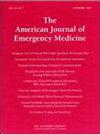与纠正措施、补救措施和急诊医生解聘有关的因素
IF 2.2
3区 医学
Q1 EMERGENCY MEDICINE
引用次数: 0
摘要
目的医疗专业精神是提供高质量患者护理的基础。缺乏数据来描述与消极的职业和就业结果相关的行为。本研究探讨导致纠正措施、补救和终止急诊医师(EPs)的常见因素。方法:这是一项横断面调查,发送给急诊医学的学术主席,以确定纠正措施、补救或终止EPs的因素。调查项目进行了试点,并在管理之前收集了响应过程的有效性。数据以描述性统计方式报告。结果167名急诊医学学术主席协会(AACEM)成员中有60人(36%)完成了调查。大多数受访者为男性(75%),至少45岁(93%),至少有20年的实践经验(85%),有5年或以上的学术主席经验(63%),并担任超过60个EPs的主席(70%)。受访者报告称,他们为大约700家公司提供了纠正措施,为371家公司提供了补救措施,并为132家公司提供了终止服务。纠正措施最常见的是:不尊重他人(82%),与护理人员的工作关系不佳(77%),学术成果不足(70%)。补救措施最常见的是:不尊重他人(47%),不合格的病人护理(43%)和与护理人员的工作关系差(42%)。终止妊娠最常见的原因是:病人护理不合格(32%),不尊重他人(23%),以及因非法活动被定罪(22%)。结论在急诊医学学术主席的调查中,ep中与就业相关的纠正措施、补救和解雇最常见的因素与专业问题有关。在终止雇佣关系之前,可能有机会解决这些问题。未来的研究应扩大到包括非急诊医学学术主席的受访者。本文章由计算机程序翻译,如有差异,请以英文原文为准。
Factors associated with corrective actions, remediation, and employment termination of emergency physicians
Objective
Medical professionalism is fundamental to the delivery of high-quality patient care. There is a paucity of data to describe behaviors associated with negative professional and employment outcomes. This study examines common factors leading to corrective actions, remediation, and termination of emergency physicians (EPs).
Methods
This was a cross-sectional survey sent to academic chairs in emergency medicine to identify factors for corrective actions, remediation, or termination of EPs. Survey items were piloted and response process validity gathered prior to administration. Data are reported as descriptive statistics.
Results
60 of 167 (36 %) members of the Association of Academic Chairs in Emergency Medicine (AACEM) completed the survey. Most respondents were male (75 %), at least 45 years of age (93 %), had been in practice for at least 20 years (85 %), had 5 or more years' experience as an academic chair (63 %), and had served as chair for more than 60 EPs (70 %). Respondents reported providing corrective action for approximately 700 EPs, remediation for 371 EPs, and termination for 132 EPs. Corrective actions were most common for: disrespecting others (82 %), poor working relationships with nursing (77 %), and insufficient academic output (70 %). Remediation was most common for: disrespecting others (47 %), substandard patient care (43 %), and poor working relationships with nursing staff (42 %). Termination was most common for: substandard patient care (32 %), disrespecting others (23 %), and conviction for illegal activity (22 %).
Conclusion
In this survey of academic chairs in emergency medicine, the most common factors of employment-related corrective actions, remediation, and termination among EPs were related to issues of professionalism. There may be opportunities to address these issues prior to employment termination. Future studies should be expanded to include survey respondents who are not academic chairs in emergency medicine.
求助全文
通过发布文献求助,成功后即可免费获取论文全文。
去求助
来源期刊
CiteScore
6.00
自引率
5.60%
发文量
730
审稿时长
42 days
期刊介绍:
A distinctive blend of practicality and scholarliness makes the American Journal of Emergency Medicine a key source for information on emergency medical care. Covering all activities concerned with emergency medicine, it is the journal to turn to for information to help increase the ability to understand, recognize and treat emergency conditions. Issues contain clinical articles, case reports, review articles, editorials, international notes, book reviews and more.

 求助内容:
求助内容: 应助结果提醒方式:
应助结果提醒方式:


